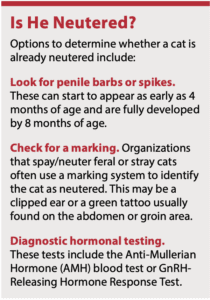The term “cryptorchid” refers to a condition in which the testicles don’t descend into the scrotum appropriately. Normally, testicles descend into the scrotum between birth and approximately 8 weeks of age.
Neutering a cat whose testicles did not get into the scrotum is still important, as those testicles are almost always there somewhere, and they will produce testosterone the same as scrotal testicles. Affected cats will likely not be fertile, as the higher temperature inside the body damages sperm, but they will almost always develop other testosterone-related characteristics like those big chunky cheeks, a territorial attitude that frequently results in urine spraying, stinky urine, and a tendency to pick fights and show aggression.
Tricky Neutering
Cats can be unilateral cryptorchids, meaning that only one testicle descended into the scrotum, or bilateral cryptorchids, meaning neither testicle made it to the scrotum. If both testicles are retained, they will usually be in the abdomen. When only one testicle is retained, it is most frequently in the inguinal canal. If no testicles are apparent in the scrotum, it’s easy to mistake a young bilateral cryptorchid male for a neutered male until he starts showing all those undesirable intact male traits at sexual maturity.
Unfortunately, feline cryptorchid neuter surgery can be challenging. Retained testicles tend to be underdeveloped and tiny compared to scrotal testicles, making them difficult to find during surgery, whether they reside in the abdomen or the inguinal canal.
Your veterinarian may find the retained testicle when he or she palpates your cat’s groin, which often makes surgery simpler. Otherwise, an ultrasound may help locate the retained testicle(s) pre-operatively.
An ultrasound isn’t a guarantee, though, as underdeveloped, retained testicles can be difficult to find even with ultrasound. It’s worth a try, however, since locating the retained testicle either in the abdomen or the groin before surgery spares your cat the possibility of multiple incisions being made in attempts to find that elusive testicle.
“In my experience, neutering cryptorchid cats can be a real conundrum,” says Dr. Kathryn Allen, DVM (Cornell 1988). “Surgically, their abdomens are very accessible, as opposed to canine abdomens where the surgeon must work around the penis situated on the lower abdomen, giving the surgeon the anticipation of a relatively easy procedure, which is sometimes the case. It is not uncommon, however, to be unsuccessful in recovering the retained testicle(s).”
When this happens, there are two possibilities: “Either the cat had only one testicle, or the second testicle was underdeveloped and so small it could not be located. The latter scenario can lead to male cat behavior problems down the road,” says Dr. Allen.
It’s possible that there are no testicles or no second testicle, but banking on this is not a good idea. Having only one testicle is called monorchidism, which is rare in cats. Anorchidism, which is when neither testicle developed, is even more unlikely. It’s better to assume they are there and decide how functional they are.
Testing for a Missing Testicle
After removing a scrotal testicle and not finding a second testicle, diagnostics to determine whether functional testicular tissue is present should be performed. It takes approximately six weeks for testosterone to be eliminated from the system after neutering. At that time, your veterinarian will examine your cat’s penis looking for evidence of tiny surface spikes or barbs that are associated with testosterone. In fully neutered cats, these barbs usually recede within six weeks. If there are no barbs and you and your veterinarian are comfortable enough to say there must not have been a second testicle, you are all set.
 You can also request an Anti-Mullerian Hormone (AMH) blood test to assess whether a testicle was missed. This hormone is produced exclusively in the sex organs. If the test is negative, then you can rest assured there is no residual testicular tissue left behind.
You can also request an Anti-Mullerian Hormone (AMH) blood test to assess whether a testicle was missed. This hormone is produced exclusively in the sex organs. If the test is negative, then you can rest assured there is no residual testicular tissue left behind.
Alternatively, your veterinarian can run a Gonadotropin-releasing hormone (GnRH) Response test. With this test, a baseline testosterone level is obtained, followed by administration of a GnRH injection, with a second testosterone level obtained two hours later. A significant rise in testosterone indicates active testicular tissue.
If it is determined that testicular tissue has been left behind, most veterinarians will refer the cat to a board-certified veterinary surgeon. Any tissue removed during this procedure will be submitted for biopsy so you will know once and for all whether your cat has been successfully neutered.




